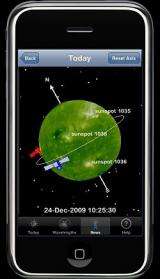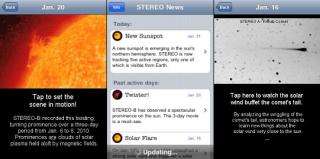3D Sun for the iPhone

Imagine holding the entire sun in the palm of your hand. Now you can. A new iPhone app developed by NASA-supported programmers delivers a live global view of the sun directly to your cell phone. Users can fly around the star, zoom in on active regions, and monitor solar activity.
"This is more than cool," says Dick Fisher, director of NASA's Heliophysics Division in Washington DC. "It's transformative. For the first time ever, we can monitor the sun as a living, breathing 3-dimensional sphere."
The name of the app is "3D Sun" and it may be downloaded free of charge at Apple's app store. Just enter "3D Sun" in the Store's search box or visit 3dsun.org for a direct link.
Realtime images used to construct the 3-dimensional sphere are beamed to Earth by the Solar-Terrestrial Relations Observatory (STEREO), a pair of spacecraft with a combined view of 87% of the solar surface. STEREO-A is stationed over the western side of the sun, while STEREO-B is stationed over the east. Together, they rarely miss a thing.
Telescopes onboard the two spacecraft monitor the sun in the extreme ultraviolet (EUV) portion of the electromagnetic spectrum. "That's why the 3D sun looks false-color green," explains Lika Guhathakurta, STEREO program scientist at NASA Headquarters. "These are not white-light images."
That's okay because EUV is where the action is. Solar flares and new sunspots shine brightly at these wavelengths. EUV images also reveal "coronal holes," vast dark openings in the sun's atmosphere that spew streams of solar wind into the solar system. Solar wind streams that hit Earth can spark intense displays of Northern Lights.
"Using this app, you can spin the sun, zoom in on sunspots, inspect coronal holes--and when a solar flare erupts, your phone plays a little jingle to alert you!" says Guhathakurta.

Indeed, many users say that's their favorite part—the alerts. The app comes alive on its own when the sun grows active or when interesting events are afoot. For example, a recent alert notified users that a comet just discovered by STEREO-A was approaching the sun. When the comet was destroyed by solar heating, the app played a movie of Comet STEREO's last hours.
Another remarkable aspect of the app is that it shows the far side of the sun—the side invisible from Earth. "This means sunspots cannot take us by surprise," Guhathakurta points out.
Recently, STEREO-B was monitoring a far side sunspot (AR1041) when the sunspot's magnetic field erupted. For the first time in almost two years, an active region on the sun produced a strong M-class1 solar flare. The unexpected interruption of the sun's deep solar minimum was invisible from Earth, but anyone with the 3D Sun had a ringside seat for the blast.
3D Sun was created by a team of programmers led by Dr. Tony Phillips, editor of Science@NASA. He says that version 1 of the app is just the beginning. Soon-to-be released 3D Sun 2.0 will offer higher-resolution images and multiple extreme ultraviolet wavelengths. These additions will reveal even more solar activity than before.
Source: Science@NASA, by Dr. Tony Phillips



















